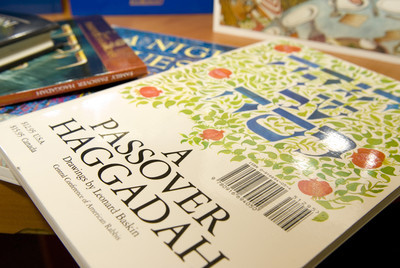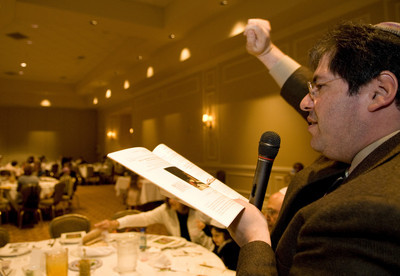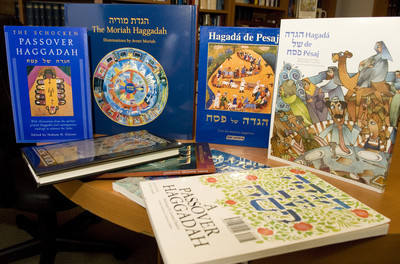SHARING THE STORY
Like many religions, Judaism is a faith forged, in large part, in tradition.
As Passover began, Jewish people around the world again made use of a remarkably adaptive tool of their faith: the Haggadah, a history of the Jewish people's deliverance from slavery and a key part of the Passover Seder.
And whether a family's Haggadah comes courtesy of a rabbinical author or the folks at a coffee company whose name you'd recognize in an instant, the reading of the Haggadah serves to reinforce not only tradition but what it means to be Jewish.
Passover, or Pesach, commemorates the liberation of the Israelites from slavery in Egypt. This year, it began at sunset Saturday and continues through sundown one week from today.
Passover marks "the birth of the Jewish people, and recognition that the Almighty controls the world and created the Jewish people for the specific purpose of helping to perfect the world and bring it to a sense of ethical monotheism," says Rabbi Yitzchak Wyne of Young Israel-Aish of Las Vegas.
"The Passover story is the central core of Jewish identity," notes Rabbi Felipe Goodman of Temple Beth Sholom, and the events recorded in the book of Exodus and retold at Passover are "what set in motion the Jewish people becoming a sovereign nation."
During Passover, Jewish families gather for a Seder, or ritualized dinner, at which symbolic foods are displayed and some eaten. Key to Passover is the requirement to eat only matzo, or unleavened bread, and, Wyne says, "to tell the story of the Jewish people leaving Egypt."
It's for the latter that the Haggadah (or the plural "Haggadot") -- a book of prayers, questions and answers, blessings and songs -- provides the script.
Haggadah means "the telling," says Rabbi Sanford Akselrad of Congregation Ner Tamid, and "goes back to the Bible when, after the Jews were liberated from their bondage, God commanded the Jewish people to tell their sons -- in other words, to tell their children -- for all time the meaning of this event."
The Haggadah is read during Seders on the first two nights of Passover. "The word 'Seder' means 'order,' and the Haggadah contains the order of the Seder," Goodman says.
The Passover Seder is, to a large extent, participatory. For example, it incorporates a question-and-answer format and opportunities not only to tell the story of Jewish liberation, but to comment on it.
"It's not told in a highly straightforward way, like Charlton Heston in (the movie) 'The Ten Commandments,' " Goodman says, but, rather, as a series of explanatory passages and questions designed to prompt discussion.
Toward that end, the Haggadah has evolved over the centuries, and continues to evolve even today. Wyne notes that, while the core story contained in the Haggadah doesn't change, the commentary around it does.
The "breadth of Judaism is so great," he adds, that "it really allows people to personalize it."
In a sense, such personalization not only is an option, but an obligation. "In every generation, you have to feel as if you, yourself, are enslaved and in redemption from Egypt," Goodman says.
There are Haggadot written with children and families in mind. There's a 30-minute Haggadah, and there are Haggadot that can be downloaded from the Internet. Some even may recall a Haggadah distributed by the makers of Maxwell House coffee. While many consider it linguistically clunky, it's still fondly remembered by many and probably remains in use by families even today.
"Now, when you want to buy a Haggadah, there are hundreds, even thousands, of varieties," Akselrad says. "They all contain the same kernel of telling the story, but everything else is fair game. You can add extra anecdotes. You can make it more humanistic or more centered in God."
Some Haggadot used in Israeli kibbutzim focus on nature, Akselrad says. "At our temple, we have one that focuses on women's rights, and this year, the men are going to (use) one that focuses on men's issues."
Wyne notes, also, that "every generation has a different need" and that the needs of Jews of particular times have been reflected in the Haggadot they've used.
In 1942, for example, "the need of the Jewish people at that time was salvation from Europe," he says. "In 1948, the need of the Jewish people was the establishment and security of the state of Israel."
And, today, in times of assimilation, Wyne says, "I think most people would agree the predominant need of the Jewish people is education and a sense of understanding what it means to be Jewish."
About 11 years ago, while serving at a Mexico City synagogue, Goodman even co-authored a Spanish-language Haggadah that, he says, since has become "the most widely used Haggadah by the Conservative movement in Latin America."
"The irony," he adds, "is that I wrote it in Mexico City then came to Las Vegas, so I was only able to use it in my own Seder once."
Contact reporter John Przybys at jprzybys@reviewjournal.com or 702-383-0280.




















